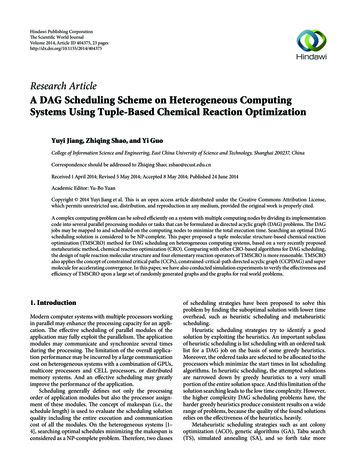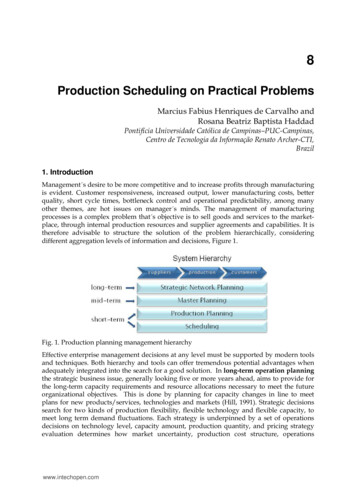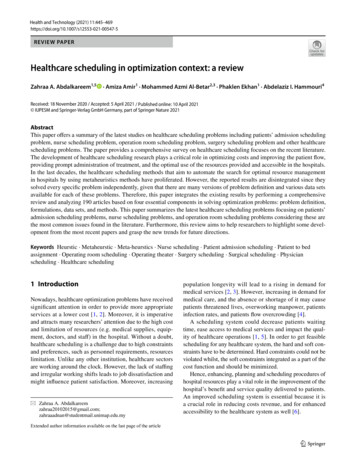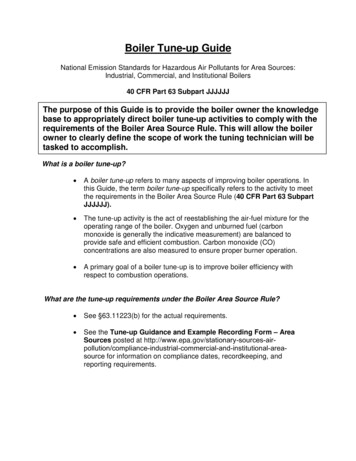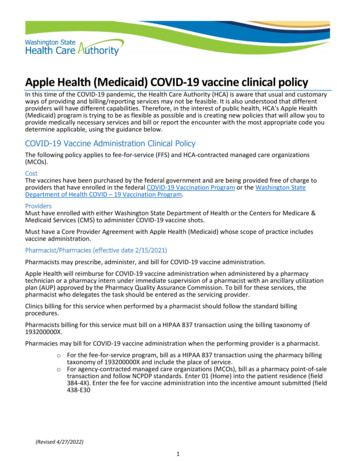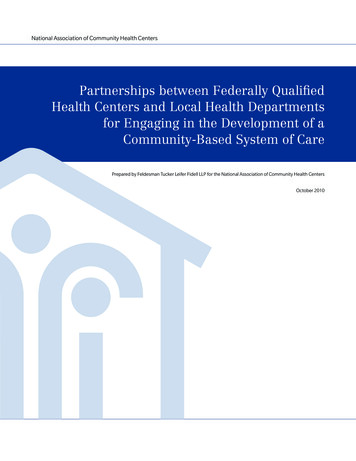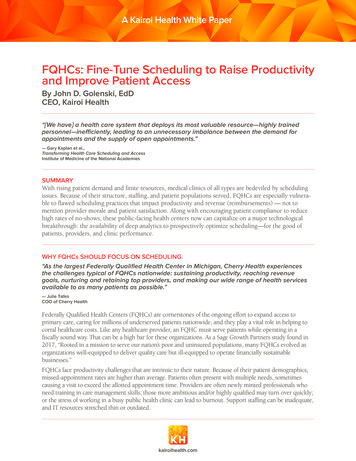
Transcription
A Kairoi Health White PaperFQHCs: Fine-Tune Scheduling to Raise Productivityand Improve Patient AccessBy John D. Golenski, EdDCEO, Kairoi Health“[We have] a health care system that deploys its most valuable resource—highly trainedpersonnel—inefficiently, leading to an unnecessary imbalance between the demand forappointments and the supply of open appointments.”— Gary Kaplan et al.,Transforming Health Care Scheduling and AccessInstitute of Medicine of the National AcademiesSUMMARYWith rising patient demand and finite resources, medical clinics of all types are bedeviled by schedulingissues. Because of their structure, staffing, and patient populations served, FQHCs are especially vulnerable to flawed scheduling practices that impact productivity and revenue (reimbursements) — not tomention provider morale and patient satisfaction. Along with encouraging patient compliance to reducehigh rates of no-shows, these public-facing health centers now can capitalize on a major technologicalbreakthrough: the availability of deep analytics to prospectively optimize scheduling—for the good ofpatients, providers, and clinic performance.WHY FQHCs SHOULD FOCUS ON SCHEDULING“As the largest Federally Qualified Health Center in Michigan, Cherry Health experiencesthe challenges typical of FQHCs nationwide: sustaining productivity, reaching revenuegoals, nurturing and retaining top providers, and making our wide range of health servicesavailable to as many patients as possible.”— Julie TatkoCOO of Cherry HealthFederally Qualified Health Centers (FQHCs) are cornerstones of the ongoing effort to expand access toprimary care, caring for millions of underserved patients nationwide, and they play a vital role in helping tocorral healthcare costs. Like any healthcare provider, an FQHC must serve patients while operating in afiscally sound way. That can be a high bar for these organizations. As a Sage Growth Partners study found in2017, “Rooted in a mission to serve our nation’s poor and uninsured populations, many FQHCs evolved asorganizations well-equipped to deliver quality care but ill-equipped to operate financially sustainablebusinesses.”FQHCs face productivity challenges that are intrinsic to their nature. Because of their patient demographics,missed-appointment rates are higher than average. Patients often present with multiple needs, sometimescausing a visit to exceed the allotted appointment time. Providers are often newly minted professionals whoneed training in care management skills; those more ambitious and/or highly qualified may turn over quickly;or the stress of working in a busy public health clinic can lead to burnout. Support staffing can be inadequate,and IT resources stretched thin or outdated.kairoihealth.com
A Kairoi Health White PaperFQHCs: Fine-Tune Scheduling to Raise Productivity and Improve Patient AccessSome of the challenges to productivity are baked into the FQHC system. But in one problem area—scheduling—clinics have a new opportunity to realize big improvements in performance. At the heart ofthe scheduling puzzle are missed appointments, which hurt productivity goals and disrupt provider workrhythms, as do appointments that run over their time slot. Both are endemic to FQHCs. Among otherscheduling pitfalls are: Clustering too many new-patient appointments Failing to optimize room usage and open times in the schedule, orto account for seasonal shifts Failing to use provider time strategically or allow providers to bookcertain kinds of appointments directly “Blind” double-booking that creates long wait times and frustratesproviders.At the heart of thescheduling puzzle aremissed appointments,which hurt productivitygoals and disrupt providerwork rhythms.Estimates vary, but a 2016 study suggests that the average nationwide rate for no-shows across all types ofclinics is nearly 19 percent. And there’s ample reason to believe that missed-appointment rates at FQHCsexceed this average. This represents a huge loss in productivity, higher administrative costs, and timewasted in a provider’s day. Patients pay a price in health, too, when they miss vital tests or necessarytreatment is delayed.When they do try to address scheduling, clinics tend to focus on modifying patient behavior, employingsystems and tech solutions that promise to bring more patients to their scheduled appointments, on time.This tactic feels intuitive, yet the real impact is typically minimal. The same study found that a centralizedphone reminder reduced no-show rates by less than a percentage point.Both experience and research convince us that clinic leaders can significantly improve productivity byfocusing their efforts on the supply side of the equation: improving availability of appointments. Theforces that affect availability—an inevitable percentage of no-shows, uneven appointment lengths, patientand provider variables, lack of standardization, and simple human error—are present in all FQHCs. Buteach has its own story and data set. Just as in the corporate world, clinics now have tools to crunch thisdata with powerful analytics and start using it strategically.MINE ACTIONABLE INSIGHTS FROM YOUR EHR“The financial health of the FQHC is always part of the strategic plan and why we work sohard at quality data reporting and meaningful use.”— Laurie Kane-LewisCEO of DFD Russell Medical Center in Leeds, MaineEvery clinic has its distinct patterns of use and performance, including scheduling. Those patterns can bediscerned by closely examining the clinic’s historical ERH data—an untapped source of actionablescheduling insights. According to a 2014 Commonwealth Fund study, 93 percent of FQHCs had an EHRsystem, a 133 percent increase from 2009—and the percentage has surely grown.kairoihealth.com
A Kairoi Health White PaperFQHCs: Fine-Tune Scheduling to Raise Productivity and Improve Patient AccessWhat kinds of data should be scrutinized? Among the variables:What kind of patient? New-patient appointments are the most subjectto cancellation, and typically take longer than ones for establishedpatients. (A double whammy: because they occupy longer slots,unkept new-patient appointments are extra-disruptive of providerschedules.) Patients with multiple issues make for longer visits.The presenting problem: Category and acuity of disease affectsappointment length. Mental and behavioral health issues can impactnot just length but likelihood of keeping an appointment. Sometimesa “single visit” can result in the patient seeing more than one provider.Clinics tend to focus onmodifying patient behavior,with solutions that promiseto bring more patients totheir scheduled appointments,on time. This tactic feelsintuitive, yet the real impactis typically minimal.Time of day, week, or year: Clinics experience higher rates ofunkept appointments on certain days and times of day, depending on location and other factors. Fluseason can mean a big increase in appointment demand (but typically appointments of short duration).Proximate civic or sporting events can affect whether patients keep appointments.Provider preferences and specialty: Some providers prefer a schedule with short breaks at a few pointsin the workday. Others are happier making a sprint through the whole morning or afternoon session,followed by a longer period to catch up with charting. Since new-patient appointments are taxing, mostproviders prefer to limit their frequency in a given day. Shorter appointments are preferred (andsuitable) for routine flu season visits, for example, or by pediatricians to qualify patients for athleticprograms. Balancing providers’ time-off requests with predicted visit need is vital to ensure enoughprovider presence (and appointments!).Appointment lead time: Appointments scheduled far in advance are highly prone to cancellation orno-shows. Especially in the FQHC realm, these patients are often calling for an urgent need rather thanseeking a primary provider—so they accept the far-out appointment as insurance, but then find quickercare elsewhere.Many of these factors contribute to missed (or fewer) appointments; all of them can influence schedulingdecisions. Until fairly recently, an experienced clinic manager would draw up provider schedules, callingon the knowledge carried in his or her memory and responding to conditions day to day. But now, withsophisticated analytics, the extensive data stored in EHR records become strategic assets. Using thesetools, clinic leaders can discover correlations and patterns that help or hinder performance, and takeappropriate action.Any data analysis is only as good as the data going in. So we adviseclients on best practices in using their EHR to improve clinicalworkflow. These include:1. Detailed and accurate recording of appointment status;carefully differentiating among appointments kept, cancelled,rescheduled, or simply missed. (“Cancelled” does not equal“rescheduled.”)2. Clearly identifying individual provider block times; notcomingling these with no-shows or cancelled appointmentsWith today’s sophisticatedanalytics, the data stored inEHR records becomestrategic assets. Usinganalytics, clinic leaders candiscover correlations andpatterns that help or hinderperformance, and takeappropriate action.3. Diligently recording provider time-in and time-out of an exam roomBefore analysis is performed, appointment errors and artifacts need to be filtered out to avoid skewing theoutput. A data-cleansing engine can be built into the analytics process.kairoihealth.com
A Kairoi Health White PaperFQHCs: Fine-Tune Scheduling to Raise Productivity and Improve Patient AccessPUTTING INSIGHTS INTO ACTIONAny scheduling solution should offer a range of options generated by data analysis and tailored to theparameters of the individual FQHC and provider. The analysis will suggest specific tactics for modifyingschedule templates. Sharing those templates with providers and key staff should be seamless.The schedule template below depicts two partial days in the life of an individual provider. This example isdesigned to show the most important scheduling options available, as presented by data analytics for thisclinic and provider: Compression. If an appointment is booked for 15 minutes, rarely is the provider in the room withthe patient for more than half of that time. Typically a nurse or other clinician rooms the patient,takes information, sets up the chart on a screen, and follow up with the patient after the provider andpatient interact. So the appointments are scheduled to overlap, as shown by offset blocks on thetemplate. Rather than being left with small scraps of unused time, the provider in this way movessmoothly from one room and patient to another—and the extra minutes accumulate over the courseof the morning, thus freeing up a solid 30 to 45 minutes at the end of the session for charting orrecovery. Filler appointments. Appointments can be added where analysis shows historical gaps inscheduling, as long as they meet the duration criteria. Or these “filler appointments” (shown in lightgreen) can be slotted into time freed up by compression—for example, during times of unexpectedheavy demand. Precision double booking—or what we call “strategic capacity loading.” These appointments areshown side by side, in the same time slot. Many clinic leaders have tried to do “blind” (uninformed)double booking as a way to increase kept appointments, only to find that it caused traffic jams in thewaiting room, irate patients, and frustrated providers. Any actual increase in revenue is minimal, andno-shows increase as patients come to dread a long wait. In contrast, strategic capacity loading is alaser-focused approach, fully informed by data analytics. (You could also call it “surgical scheduling,”in the sense that it cuts sharply and accurately!) It can pinpoint which appointment slots, based onkairoihealth.com
A Kairoi Health White PaperFQHCs: Fine-Tune Scheduling to Raise Productivity and Improve Patient Accessanalyzing the clinic’s records, have the highest probability of a no-show—and thus where doublebooking will improve the odds of a kept appointment. The capability to predict and act on thelikelihood of a no-show is the most powerful tool in scheduling. Airlines have long known this, andcarefully target a level of double booking using key parameters for that industry. In a clinic, the worstconsequence is longer wait times—but data analytics can virtually ensure that a historical no-showmeans a slot waiting to be filled. Structuring by provider preference. There are many ways to dothis; in the template, note the 30-minute appointment slots thatoccur periodically through the provider’s morning. Very often thelonger times are designated for new patients, and some providersprefer to deal with those as early as possible in the day, or theweek. Others would rather schedule them just before a catch-upperiod, so they can use that time for the extra charting involved.The capability to predictand act on the likelihood ofa no-show is the mostpowerful tool in scheduling.Clinic decision makers also need the capability to dial in varying levels of sensitivity to historicalpatterns—adjusting the decision threshold as they modify the schedule template. They may set a specificgoal: for example, recovering one additional kept appointment per provider per day. If an action undulyimpacts patient wait times or provider rhythms, they may dial things back.Over time, as clinic leaders perform and constantly refine data analysis for their patient population andtheir entire team of providers, the big picture of potential productivity gains becomes clearer.CONCLUSIONIt’s abundantly clear that FQHCs need to increase productivity (numbers of patients seen effectively in agiven clinic day), account more accurately for their work in order to increase revenue, maintain andenhance provider morale in order to recruit and retain providers, and keep patients happy enough to keepcoming for care.To remain financially sustainable in the current and coming marketplace, they also need to expand theirbusiness, offering their primary care services to new patient populations. However, workflow issues areamong the most-cited obstacles to serving more mainstream patients. As FQHC leaders seek ways toredesign clinic workflow and improve productivity, they will increasingly need to employ analytics thattarget the supply of appointments.“FQHCs are more important to their communities than ever before, but success today demands adifferent, multi-faceted, and much more strategic approach,” says a recent Sage Growth Partners survey.We couldn’t agree more. Our company, Kairoi Health, has developed a SaaS solution, KairoiSuite ,designed from the ground up to perform state-of the-art schedule optimization as described in this paper.My colleague Jeff Dao adds, “It’s time for healthcare organizations to do what corporate America did yearsago—make smart use of the data residing in their information systems.”kairoihealth.com
A Kairoi Health White PaperFQHCs: Fine-Tune Scheduling to Raise Productivity and Improve Patient AccessDr. John Golenski cofounded Kairoi Health in 2014 and has guided its growth andevolution from a services group to a company creating products that target the mosturgent issues in healthcare. His depth of experience spans clinical services management, health policy, physician leader training, and primary care redesign. Over hislong career of industry leadership, he has worked in 49 of the 50 United States, inwidely varied regional medical cultures and both inpatient and outpatient settings,on key issues from benefits design to personnel management, and from patientbedsides to forums of national and international health policy. Read his full bio.SOURCESAmerican Association of Health Centers. America’s Health Centers (fact sheet).At ericasHealthCenters FINAL.pdfBrandenburg, Lisa, with Patricia Gabow, Glenn Steele, John Toussaint, and Bernard J. Tyson.Innovation and Best Practices in Health Care Scheduling. Discussion Paper, Institute of Medicine, National Academy ofSciences (February 2015). At est-practices-in-health-care-scheduling/DeMarco, Christopher. The High Performing FQHC of Tomorrow: Expanding the Mission through Margin.Sage Growth Partners, white paper (2015).At th Resources & Services Administration. About the Health Center Program.At https://bphc.hrsa.gov/about/index.htmlHospital IQ. Using Analytics, Machine Learning, and Simulation Technology to Better Manage Patient Flow (whitepaper) https://www.hospiq.com/downloads/HIQ PatientFlow white paper.pdfKaplan, Gary, with Marianne Hamilton Lopez, and J. Michael McGinnis, editors. Transforming Health Care Schedulingand Access: Getting to Now. Committee on Optimizing Scheduling in Health Care; Institute of Medicine; Washington(DC): National Academies Press (US); 2015 Aug 24. At khah, Parviz, with Qianmei Feng, Lauren M. Travis, Shahriar Tavakoli-Tabasi, and Amir Sharafkhane.Prevalence, predictors and economic consequences of no-shows. BMC Health Services Research (BioMed /PMC4714455/Pasupathy, R., with S.-H. Kim, A. Tolk, R. Hill, and M. E. Kuhl, eds. Managing Patient Flow at a New York City FederallyQualified Health Center. Proceedings of the 2013 Winter Simulation ludes/files/390.pdfRyan, Jamie, with Michelle M. Doty, Melinda K. Abrams, and Pamela Riley. The Adoption and Use of Health InformationTechnology by Community Health Centers, 2009–2013. The Commonwealth Fund pub. 1746, Vol. 10. iles/documents/ media files publications issue brief 2014 may1746 ryan adoption use hlt it chcs rb.pdfSage Growth Partners. State of the FQHC 2017, A Sage Growth Partners Research Report.At ite is a trademark of Kairoi Healthcare Strategies, Inc.kairoihealth.com
scheduling—clinics have a new opportunity to realize big improvements in performance. At the heart of the scheduling puzzle are missed appointments, which hurt productivity goals and disrupt provider work rhythms, as do appointments that run over their time slot. Both are endemic to FQHCs. Among other scheduling pitfalls are:

